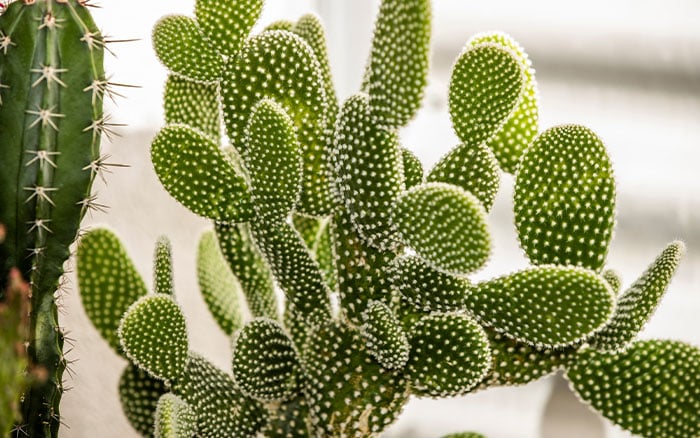Cacti are fantastic houseplants and are often a go-to for houseplant beginners because of their low-maintenance care. They don’t demand much care, making them great for busy households. However, if you need to repot or move a cactus, here’s a guide to transplanting a cactus so you can do it safely.
All about cacti
Cacti are one of the most fool-proof houseplants, making them popular for beginners. They are great for busy households because they don’t require much watering. Available in a huge range of sizes, shapes, and textures, there is sure to be a cactus to suit your space.
They do look great on a sunny windowsill, but they do lend themselves well to being planted up as part of a desertscape terrarium. For terrariums with succulents and cacti, you’ll want to choose an open container which will allow more moisture control.
Mammillaria hahniana (old lady cactus) looks like a pincushion. Then there’s Astrophytum asteria (star cactus) and the fun looking Opuntia microdasys (bunny ears cactus). Position these together, and decorate with gravel, painted pebbles, or embellish to suit your décor, and it’ll fit right in.

Repotting a cactus
One tell-tale sign that your cactus needs repotting is if the roots show through the drainage holes. As a typical rule, cacti need repotting once every two to three years. However, if they are slow growing species like Saguaro, every 4 years may be more suitable.
Cacti are hardy plants, and as desert plants they need sufficient light to thrive. If the cactus is in good condition before repotting, the good news is that it will bounce back and establish in its new pot if placed in the same position with the same access to light and air circulation.

How to repot a cactus
The supplies you need will depend on the size of the cactus, and of course the type as this will impact its spikiness. Although, whatever the size, wearing gloves is ideal as a layer of protection.
To start off, use a trowel to loosen the cactus from the original pot. To protect your hands as an extra measure to gloves, it can be useful to wrap the cactus in newspaper to get easier hold of it.
Another way of protecting the plant and your hands when repotting a cactus with big spikes is to use bubble wrap. This is because you don’t want to damage the spikes or your hands, so it’s beneficial for both.
Once the plant is removed from the pot, loosen the root ball, shaking off any old soil and discarding it. If the plant is rootbound, this can take a while because the roots are delicate. This is the perfect time to check the roots for any dead, diseased, or damaged roots. If there are any, these can be cut back so the roots are all fresh.
If you are repotting because the plant is rootbound, choose a new pot that is slightly larger than the original one. When choosing the material, bear in mind that clay pots can be ideal because they help to prevent the risk of overwatering because the material absorbs excess moisture. The most important thing to bear in mind when choosing the container is that there are sufficient drainage holes as cacti need free-draining soil.
Fill the new container with peat-free cactus potting mix and plant the cactus as the same depth as it was previously. Again, use newspaper or a towel to handle to cactus to fill the rest of the pot with potting mix, firming down well.
Unlike many plants, repotted cacti shouldn’t be watered in as soon as they’re in place. Instead, leave them for a week to settle into the new surroundings, and then the watering schedule can be resumed as normal.


Leave A Comment